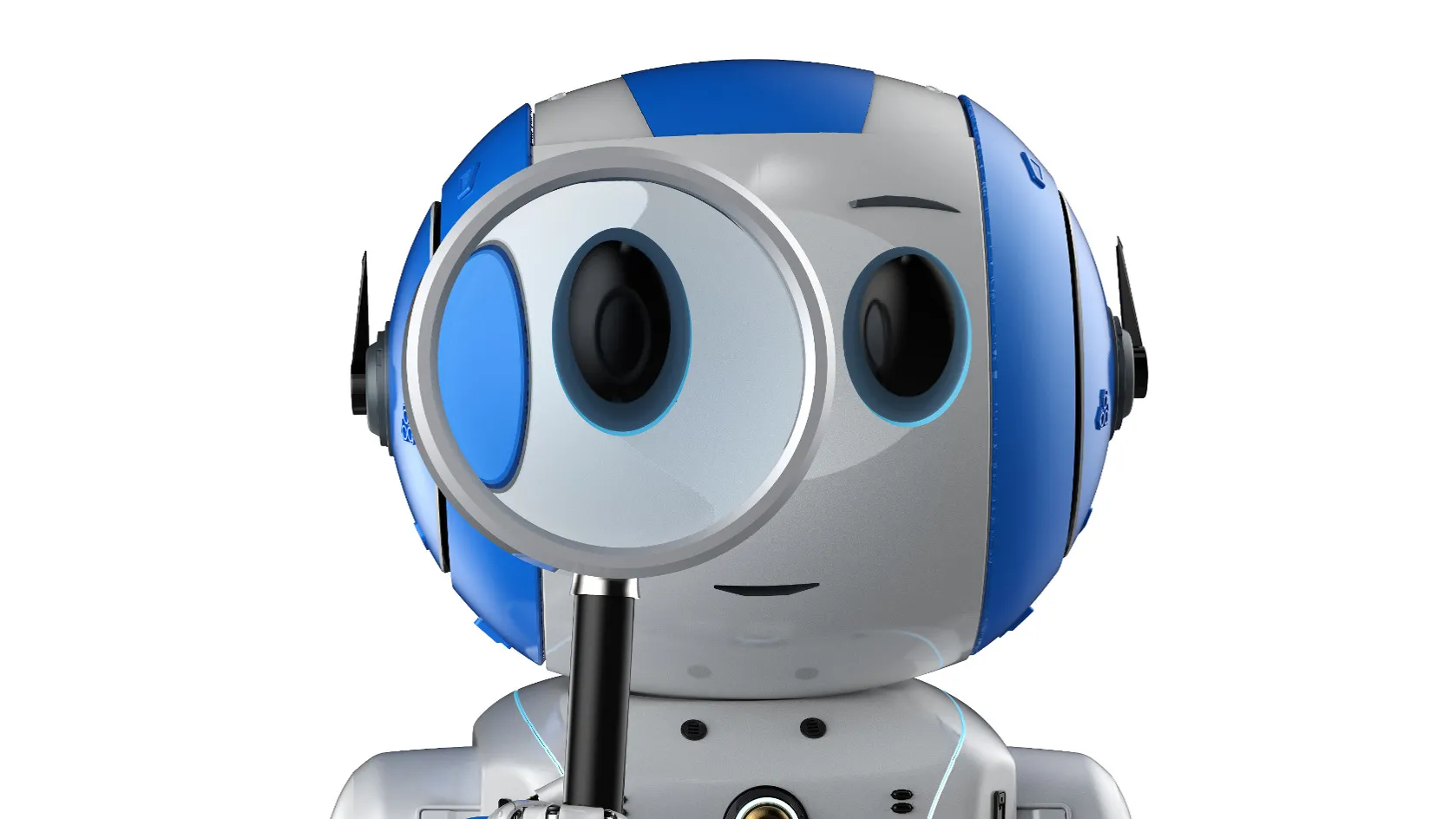
Movies can be a good place to see what the future looks like. According to Robert Wallace, a retired director of the CIA’s Office of Technical Service: “… When a new James Bond movie was released, we always got calls asking, ‘Do you have one of those?’ If I answered ‘no’, the next question was, ‘How long will it take you to make it?’ Folks didn’t care about the laws of physics or that Q was an actor in a fictional series—his character and inventiveness pushed our imagination …”3 As an example, the CIA successfully copied the shoe-mounted spring-loaded and poison-tipped knife in From Russia With Love. It’s interesting to speculate on what else Bond movies may have led to being invented.
For this reason, I have been considering what movies predict about the future of artificial intelligence (AI). One theme that emerges in several science fiction movies is that of an AI mistaken for human. In the classic movie Blade Runner, Rick Deckard (Harrison Ford) tracks down and destroys replicants that have escaped and are visually indistinguishable from humans. Tantalizingly, the film leaves open the question of whether Rick Deckard is himself a replicant. More recently, the movie Ex Machina centers around a type of Turing Test in which the robot Ava tries to be convincingly human enough to trick someone into helping her escape. And in Metropolis, one of the very first science fiction movies ever, a robot disguises itself as the woman Maria and thereby causes the workers to revolt.
It thus seems likely that sometime in the future we will have to deal with the impact of AI’s being mistaken for humans. In fact, it could be argued that this future is already here. Joseph Weizenbaum proposed ELIZA as a “parody” of a psychotherapist and first described the program in the pages of Communications in 1966.4 However, his secretary famously asked to be left alone so she could talk in private to the chatterbot. More recently a number of different chatterbots have fooled judges in the annual Loebner prize, a version of the Turing Test.
Alan Turing, one of the fathers of artificial intelligence, predicted in 1950 that computers would be mistaken for humans in around 50 years.2 We may be running a little late on this prediction. Nevertheless the test Alan Turing proposed in the very same paper that contains his 50-year prediction remains the best known test for AI (even if there are efforts under way to update and refine his test). Let us not forget that the Turing Test is all about an AI passing itself off as a human. Even if you are not a fan of the Turing Test, it nevertheless has placed the idea of computers emulating humans firmly in our consciousness.
As any lover of Shakespeare knows, there are many dangers awaiting us when we try to disguise our identity. What happens if the AI impersonates someone we trust? Perhaps they will be able to trick us to do their bidding. What if we suppose they have human-level capabilities but they can only act at a sub-human level? Accidents might quickly follow. What happens if we develop a social attachment to the AI? Or worse still, what if we fall in love with them? There is a minefield of problems awaiting us here.
This is not the first time in history that a technology has come along that might disrupt and endanger our lives. Concerned about the impact of motor vehicles on public safety, the U.K. parliament passed the Locomotive Act in 1865. This required a person to walk in front of any motorized vehicle with a red flag to signal the oncoming danger. Of course, public safety wasn’t the only motivation for this law as the railways profited from restricting motor vehicles in this way. Indeed, the law clearly restricted the use of motor vehicles to a greater extent than safety alone required. And this was a bad thing. Nevertheless, the sentiment was a good one: until society had adjusted to the arrival of a new technology, the public had a right to be forewarned of potential dangers.
Interestingly, this red flag law was withdrawn three decades later in 1896 when the speed limit was raised to 14mph (approximately 23kph). Coincidently, the first speeding offense, as well as the first British motoring fatality, the unlucky pedestrian Bridget Driscoll also occurred in that same year. And road accidents have quickly escalated from then on. By 1926, the first year for which records are available, there were 134,000 cases of serious injury, yet there were only 1,715,421 vehicles on the roads of Great Britain. That is one serious injury each year for every 13 vehicles on the road. And a century later, thousands still die on our roads every year.
Inspired by such historical precedents, I propose that a law be enacted to prevent AI systems from being mistaken for humans. In recognition of Alan Turing’s seminal contributions to this area, I am calling this the Turing Red Flag law.
There are many reasons we don’t want computers to be intentionally or unintentionally fooling us.
Turing Red Flag law: An autonomous system should be designed so that it is unlikely to be mistaken for anything besides an autonomous system, and should identify itself at the start of any interaction with another agent.
Let me be clear. This is not the law itself but a summary of its intent. Any law will have to be much longer and much more precise in its scope. Legal experts as well as technologists will be needed to draft such a law. The actual wording will need to be carefully crafted, and the terms properly defined. It will, for instance, require a precise definition of autonomous system. For now, we will consider any system that has some sort of freedom to act independently. Think, for instance, self-driving car. Though such a car does not choose its end destination, it nevertheless does independently decide on the actual way to reach that given end destination. I would also expect that, as is often the case in such matters, the exact definitions will be left to the last moment to leave bargaining room to get any law into force.
There are two parts to this proposed law. The first part of the law states that an autonomous system should not be designed to act in a way that it is likely to be mistaken there is a human in the loop. Of course, it is not impossible to think of some situations where it might be beneficial for an autonomous system to be mistaken for something other than an autonomous system. An AI system pretending to be human might, for example, create more engaging interactive fiction. More controversially, robots pretending to be human might make better caregivers and companions for the elderly. However, there are many more reasons we don’t want computers to be intentionally or unintentionally fooling us. Hollywood provides lots of examples of the dangers awaiting us here. Such a law would, of course, cause problems in running any sort of Turing Test. However, I expect that the current discussion about replacements for the Turing Test will eventually move from tests for AI based on deception to tests that quantify explicit skills and intelligence. Some related legislation has been put into law for guns. In particular, former California Governor Schwarzenegger signed legislation in September 2004 that prohibits the public display of toy guns in California unless they are clear or painted a bright color to differentiate them from real firearms. The purpose of this law is to prevent police officers mistaking toy guns for real ones.
The second part of the law states that autonomous systems need to identify themselves at the start of any interaction with another agent. Note that this other agent might even be another AI. This is intentional. If you send your AI bot out to negotiate the purchase of a new car, you want the bot also to know whether it is dealing with a dealer bot or a person. You wouldn’t want the dealer bot to be able to pretend to be a human just because it was interacting with your bot. The second part of the law is designed to reduce the chance that autonomous systems are accidently mistaken for what they are not.
Consider four up-and-coming areas where this law might have bite. First, consider autonomous vehicles. I find it a real oversight that the first piece of legislation that permits autonomous vehicles on roads, the AB 511 act in Nevada, says nothing at all about such vehicles being identified to other road users as autonomous. A Turing Red Flag law, on the other hand, would require an autonomous vehicle identify itself as autonomously driven both to human drivers and to other autonomous vehicles. There are many situations where it could be important to know that another road vehicle is being driven autonomously. For example, when a light changes we can suppose that an autonomous vehicle approaching the light will indeed stop, and so save us from having to brake hard to avoid an accident. As a second example, if an autonomous car is driving in front of us in fog, we can suppose it can see a clear road ahead using its radar. For this reason, we do not have to leave a larger gap in case it has to brake suddenly. As a third example, at a four-way intersection, we can suppose an autonomous car will not aggressively pull out when it does not have right of way. And as a fourth and final example, if an autonomous car arrives at a diversion, we might expect it to drive more slowly as it tries to work out where the road is now going.
How should an autonomous vehicle identify itself? I don’t suppose this should be with a person walking in front with a red flag. This was too restrictive even back in 1865. Autonomous vehicles might have to carry distinctive plates, just like we require learner drivers to identify themselves on the roads today. Or autonomous vehicles might have to display a magenta flashing light whenever they are being operated autonomously. In addition, autonomous vehicles should broadcast their location, velocity, and autonomy to neighboring vehicles.
In June 2015, Reuters reported that two autonomous cars, one from Google and the other from Delphi Automotive Plc, nearly had an accident on a Silicon Valley street. The Google car apparently cut off the Delphi car as it was about to perform a lane change. The Delphi car then had to take “appropriate action” to avoid an accident. Clearly, it would help prevent such incidents if autonomous vehicles were required to broadcast their location and intentions. Of course, adequate safeguards will also need to be put in place that such broadcasting does not compromise the privacy of their human occupants.
Once autonomous vehicles are commonplace, other motorists will expect to meet autonomous vehicles. But before this time, it will be important to know that the oncoming vehicle is somewhat special and may behave differently to a human driver. In the past, it was less necessary for autonomous vehicles to identify themselves. There were few of them and most looked a little odd. The presence of large rotating LIDAR sensors on their roofs has tended to give the game away. However, now that the technology is shrinking and autonomous cars are starting to look more normal, it will become increasingly difficult to know when a car is being driven autonomously. There is also a reverse argument. Suppose autonomous vehicles are (or become) better drivers than humans. Then just like today when we demand less experienced and capable learner drivers are identified, we might demand that human drivers are identified apart from autonomous drivers. A Turing Red Flag law will achieve this.
Let’s move on to the second area where a Turing Red Flag law might start having impact shortly. Consider virtual assistants like Apple’s Siri or Microsoft’s Cortana. Here is a recent conversation I had with Siri:
Siri. What can I help you with?
Q. Are you a computer?
Siri. I can neither confirm nor deny my current existential status.
Q. Are you a human?
Siri. I’m an assistant. That’s all that matters.
Q. Are you an AI?
Siri. That’s a rather personal question.
Based on conversations like these, it would appear that Siri is coming close to violating this proposed Turing Red Flag law. It begins its conversations without identifying itself as a computer, and it answers in a way that, depending on your sense of humor, might deceive. At least, in a few years time, when the dialogue is likely more sophisticated, you can imagine being deceived. Of course, few if any people are currently deceived into believing that Siri is human. It would only take a couple of questions for Siri to reveal that it is not human. Nevertheless, it is a dangerous precedent to have technology like this in everyday use on millions of smartphones pretending, albeit poorly, to be human.
There are also several more trusting groups that could already be deceived. My five-year-old daughter has a doll that uses a Bluetooth connection to Siri to answer general questions. I am not so sure she fully appreciates that it is just a smartphone doing all the clever work here. Another troubling group are patients with Alzheimer’s disease and other forms of dementia. Paro is a cuddly robot seal that has been trialed as therapeutic tool to help such patients. Again, some people find it troubling that a robot seal can be mistaken for real. Imagine then how much more troubling society is going to find it when such patients mistake AI systems for humans?
Let’s move onto a third example, online poker. This is a multibillion-dollar industry so it is possible to say that the stakes are high. Most, if not all, online poker sites already ban computer bots from playing. Bots have a number of advantages, certainly over weaker players. They never tire. They can compute odds very accurately. They can track historical play very accurately. Of course, in the current state of the art, they also have disadvantages such as understanding the psychology of their opponents. Nevertheless, in the interest of fairness, I suspect most human poker players would prefer to know if any of their opponents was not human. A similar argument could be made for other online computer games. You might want to know if you’re being “killed” easily because your opponent is a computer bot with lightning-fast reflexes.
I conclude with a fourth example: computer-generated text. Associated Press now generates most of its U.S. corporate earnings reports using a computer program developed by Automated Insights.1 A narrow interpretation might rule such computer-generated text outside the scope of a Turing Red Flag law. Text-generation algorithms are typically not autonomous. Indeed, they are typically not interactive. However, if we consider a longer time scale, then such algorithms are interacting in some way with the real world, and they may well be mistaken for human-generated text. Personally, I would prefer to know whether I was reading text written by human or computer—it is likely to impact my emotional engagement with the text. But I fully accept that we are now in a grey area. You might be happy for automatically generated tables of stock prices and weather maps to be unidentified as computer generated, but perhaps you do want match reports to be identified as such? What if the commentary on the TV show covering the World Cup Final is not Messi, one of the best footballers ever, but a computer that just happens to sound like Messi? And should you be informed if the beautiful piano music being played on the radio is composed by Chopin or by a computer in the style of Chopin? These examples illustrate that we still have some way to go working out where to draw the line with any Turing Red Flag law. But I would argue, there is a line to be drawn somewhere here.
I suspect most human poker players would prefer to know if any of their opponents was not human.
There are several arguments that can be raised against a Turing Red Flag law. One argument is that it’s way too early to be worrying about this problem now. Indeed, by flagging this problem today, we’re just adding to the hype around AI systems breaking bad. There are several reasons why I discount this argument. First, autonomous vehicles are likely only a few years away. In June 2011, Nevada’s Governor signed into law AB 511, the first legislation anywhere in the world that explicitly permits autonomous vehicles. As I mentioned earlier, I find it surprising that the bill says nothing about the need for autonomous vehicles to identify themselves. In Germany, autonomous vehicles are currently prohibited based on the 1968 Vienna Convention on Road Traffic to which Germany and 72 other countries follow. However, the German transport minister formed a committee in February 2015 to draw up the legal framework that would make autonomous vehicles permissible on German roads. This committee has been asked to present a draft of the key points in such a framework before the Frankfurt car fair in September 2015. We may therefore already be running late to ensure autonomous vehicles identify themselves on German roads. Second, many of us have already been fooled by computers. Several years ago a friend asked me how the self-service checkout could recognize different fruit and vegetables. I hypothesized a classification algorithm, based on color and shape. But then my friend pointed out the CCTV display behind me with a human operator doing the classification. The boundary between machine and man is quickly blurring. Even experts in the field can be mistaken. A Turing Red Flag law will help keep this boundary sharp. Third, humans are often quick to assign computers with more capabilities than they actually possess. The last example illustrates this. As another example, I let some students play with an Aibo robot dog, and they quickly started to ascribe the Aibo with emotions and feelings, neither of which the Aibo has. Autonomous systems will be fooling us as human long before they actually are capable to act like humans. Fourth, one of the most dangerous times for any new technological is when the technology is first being adopted, and society has not yet adjusted to it. It may well be, as with motor cars today, society decides to repeal any Turing Red Flag laws once AI systems become the norm. But while they are rare, we might well choose to act a little more cautiously.
In many U.S. states, as well as many countries of the world including Australia, Canada, and Germany, you must be informed if your telephone conversation is about to be recorded. Perhaps in the future it will be routine to hear, “You are about to interact with an AI bot. If you do not wish to do so, please press 1 and a real person will come on the line shortly.”




Join the Discussion (0)
Become a Member or Sign In to Post a Comment